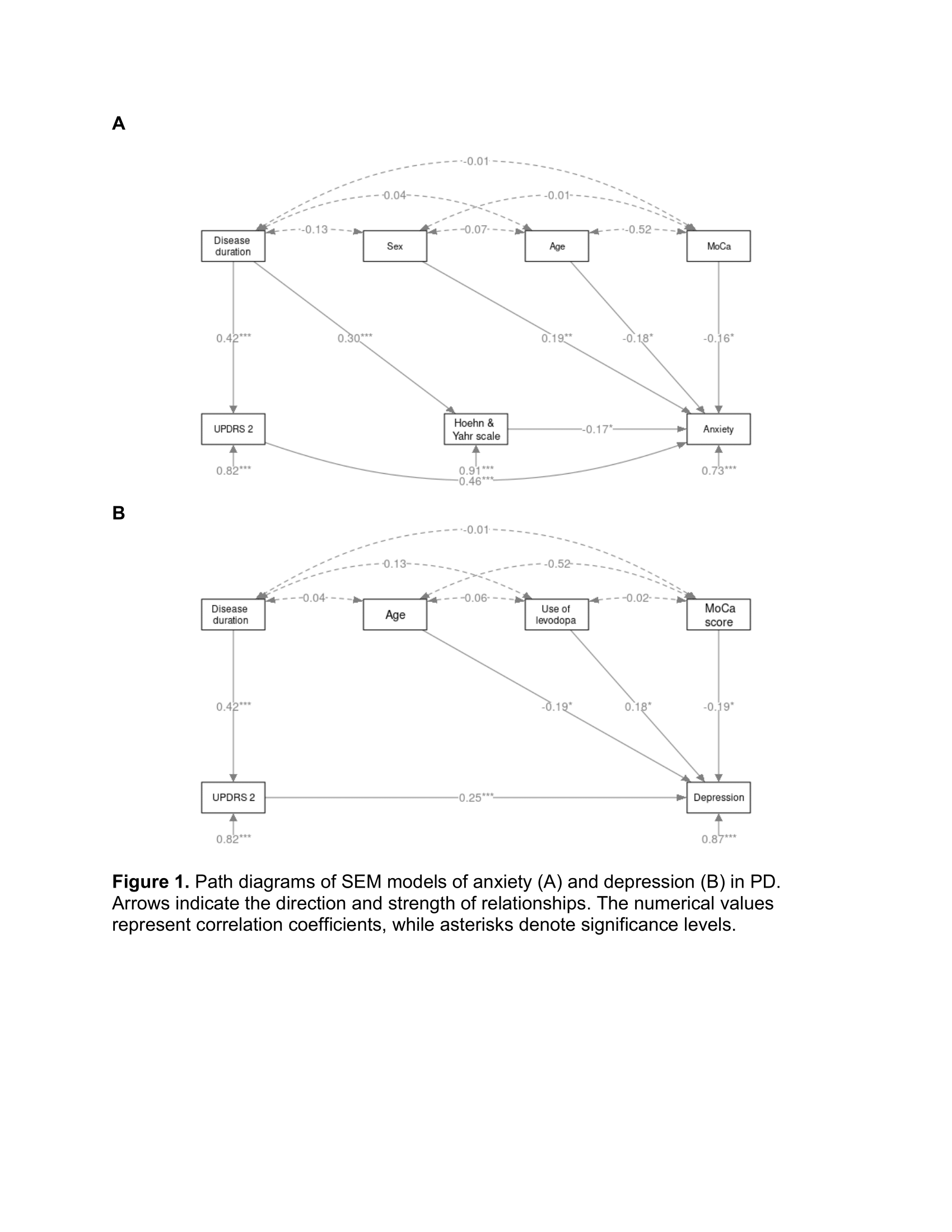Objective: This study, conducted within the Mexican Parkinson’s Disease Research Network (MEX-PD), aims to explore whether depression and anxiety in PD patients primarily stem from Parkinson’s-specific factors or are influenced by external variables
Background: Depression and anxiety are highly prevalent non-motor symptoms in Parkinson’s Disease (PD) patients, necessitating a comprehensive understanding of their etiology for optimized care. Structural equation models (SEM) provide a good alternative as they offer a holistic approach, facilitating the simultaneous assessment of multiple variables, both PD-specific and nonspecific, thereby enabling a thorough exploration of the complex relationships underlying these psychological symptoms
Method: We constructed two structural equation models to delineate the direct and indirect effects of PD-specific and nonspecific factors on anxiety and depression, employing the lavaan library in R version 4.1.2. Our analysis involved 165 participants (64 women, 101 men; mean age 64.1 years). Depression and anxiety symptoms were assessed using the State-Trait Depression Inventory (ST-DEP) and the State-Trait Anxiety Inventory (STAI), respectively.
PD-specific factors encompassed disease duration, Hoehn & Yahr score, motor symptom severity assessed by UPDRS-3 score, limitations in disease-related activities of daily living (ADL) assessed by UPDRS-2 score, dyskinesia presence, levodopa, and dopamine agonist usage. Nonspecific factors included sex, age, cognitive function assesed by MoCa score, personal history of anxiety/depression, and other comorbidities.
Results: Our preliminary findings suggest that sex, age, and MoCa directly influence anxiety, while disease duration indirectly affects anxiety through mediation by UPDRS-2 score and the Hoehn & Yahr scale (Figure 1A). Regarding depression, age, levodopa usage, and MoCa score directly impact depression, while disease duration indirectly affects depression through mediation by UPDRS-2 (Figure 1B). Age and MoCa emerge as significant nonspecific factors, with disease duration being the predominant PD-specific factor in both models. Next steps will include assessment of model fit.
Conclusion: These insights offer valuable implications for tailored management approaches in PD patients within the MEX-PD cohort
Figure 1
To cite this abstract in AMA style:
P. Reyes-Pérez, D. Martínez, I. Estrada-Bellmann, C. Guerra-Galicia, N. Gandarilla-Martínez, E. Morelos Figaredo, K. Salinas-Barboza, Y. Matuk-Pérez, A. Lazaro-Figueroa, M. Rentería, S. Alcauter-Solorzano, A. Ruiz-Contreras, A. Medina-Rivera. Modeling the Role of Parkinson’s Disease-Specific Factors in Depression and Anxiety: Findings from MEX-PD Cohort [abstract]. Mov Disord. 2024; 39 (suppl 1). https://www.mdsabstracts.org/abstract/modeling-the-role-of-parkinsons-disease-specific-factors-in-depression-and-anxiety-findings-from-mex-pd-cohort/. Accessed December 23, 2025.« Back to 2024 International Congress
MDS Abstracts - https://www.mdsabstracts.org/abstract/modeling-the-role-of-parkinsons-disease-specific-factors-in-depression-and-anxiety-findings-from-mex-pd-cohort/

